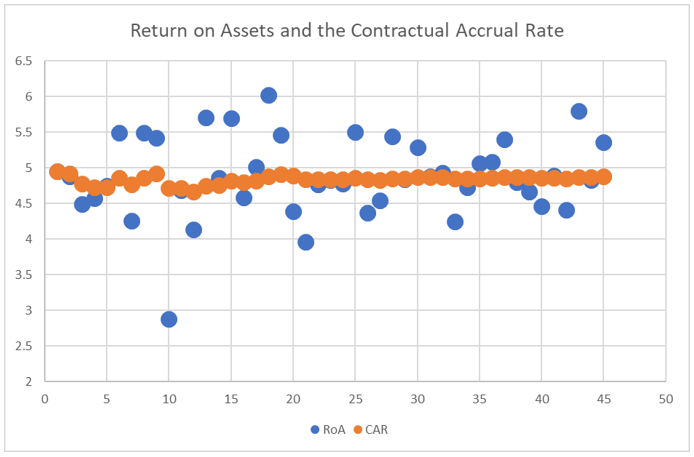Governance & Regulation For Collective Defined Contribution Schemes
Tuesday, 11 December 2018By Anna Tilba & Con Keating
Introduction
This paper was prompted by the Department of Work and Pensions consultation on CDC pensions[1]. It addresses some of the implicit and explicit concerns, questions and proposals contained in that paper.
Our belief is that many of these concerns are avoidable difficulties and much of the proposed regulation unnecessary if the scheme rules (including governance processes) are appropriately designed. We shall offer one particular form of scheme as a straw man, but recognise that many designs may be both feasible and desirable for scheme members.
The defining characteristic of a CDC scheme is that its targeted benefits may be reduced if the level of scheme funding does not warrant payment. There are no guarantees of the targeted benefits from any party. In the current DWP vision, these are occupational schemes but the role of the employer is limited to the payment of current contributions, and, unlike Defined Benefit schemes, there is no further recourse. This means that the fund, the portfolio of assets arising from contributions, is all there is. This determines the amounts that may be paid as pensions.

We note that as currently envisaged in the consultation, it is likely that the initial promotion of the scheme, along with scheme trust deed and rules, and the appointment of initial trustees will be undertaken by a sponsoring employer. We will revisit this later.
It is proposed that CDC scheme would be categorised as a form of the existing money purchase classification for legislative purposes. This is appropriate and reinforces the independent stand-alone nature of the scheme, as Pension Protection Fund cover would not apply.[2]
The proposals that these schemes are required to be occupational trust-based pension schemes with their main place of administration in the UK, and that they will also need to be registered with HMRC for tax purposes, and be authorised by The Pensions Regulator before they can receive contributions are entirely non-contentious, if rather limited in the scope of application.
As an aside, it would be quite difficult to offer the full flexibilities of CDC in a contractual framework.
Governance
The overall purpose of a CDC pension fund is to provide retirement benefits to its members at costs acceptable to the employer[3] and members. Trustees’ duties in relation to the fund are to act prudently, honestly and in the best interest of the members.[4] The Pensions Regulator states that trustees must ensure that pension fund investments deliver value for money and good investment outcomes. There are only a few academic studies that examine UK pension funds’ governance[5]. None of which look into the CDC arrangement. We now fill in this important gap.
The independence and collective nature of the scheme endows CDC with the characteristics of a member mutual organisation. As this is organised as a trust[6], it is important that the trustees[7] should all be elected by the membership. The electoral process should be one person one vote and simple majority. There is merit[8] in having one third of the trustees retiring in each year; retiring trustees may be eligible for re-election. Trustees do not need to be members of the scheme.
Upon creation and authorisation of a scheme, the members should ratify or revise the scheme rules and the appointed trustees by formal vote.
The chair of the trustees should be proposed by the trustees for confirmation or rejection by vote of the membership; the chair need not be a member of the scheme. Again, a simple majority will suffice.

The duties of the trustees are similar in many regards to their fiduciary duties[9] under defined benefit arrangements, but go further. The prime responsibility of the trustees is to set the terms of new benefit award annually. We include in this description designs where the contribution rate and benefit awards are fixed over some multi-year period. But overarchingly the trustees are responsible for ensuring adherence to scheme rules. These rules determine not just the operations of the scheme, but also its governance[10].
We have indicated the rules by which trustees may be appointed; in addition to this there are further matters which require the attention of the membership. The first and most obvious of these is alteration of existing scheme rules, where a super-majority (say 75%) seems appropriate. Perhaps less obvious is the question of scheme wind-up.
There is an argument for some sponsor involvement, including possibly the right to appoint some of the trustees. This argument centres on the fact that the employer is the person who decided on whether to establish and offer the scheme to its employees (consulting, as applicable, recognised trade unions or agreeing the position of the recognised trade unions). On an ongoing basis, the employer is going to determine (with consultation or agreement with trustees) the contribution rates and benefit design – the job of the trustees is then to execute the benefit design. But with scheme rules and trustees adopted and perhaps adapted by the membership, this argument is weak. It is difficult to see that the sponsor has any further needed involvement, though there may be some residual, if formless, reputational risk to them.
It is also an open question as to whether trustees should be elected from certain constituencies, such as active, pensioner and deferred members. We are not convinced by the arguments that they will represent the interests of their member constituency, as this would imply that they are not fulfilling the requirement to treat all members equally. We would suggest that an open attitude be taken to design variants such as this, and that time will inform us as to the superiority or not of the possible designs.
Sustainability
The consultation makes much of the question of scheme sustainability and proposes, among other things, that the Pensions Regulator should have the power of compulsory wind-up. The Regulator already has a power to wind up a pension scheme if it is in the interests of the members under Section 11 of the Pensions Act 1995. In a scheme in which benefits may be cut, sustainability is an elusive concept. Similarly, the best or even just the interests of members is disputable[11]. We believe that wind-up is a matter for the membership in light of the experience and prospects for the scheme, and their tolerance and preferences for that. Accordingly, we would subject any decision to wind-up to a vote of the membership, which would be final and binding. Such a motion might be proposed by some minimal group of members, say 50, the board of trustees, or the Pensions Regulator. Such extraordinary measures would be complemented by disclosure rules and notice periods. We would also suggest that such measures, if rejected, should not be revisited more frequently than annually, unless there is a material change of the scheme’s circumstances. We would also note that non-agreeing members have the option to transfer out (to another scheme) their equitable interest at its net asset value. However, such action might result in loss of any further future employer contributions.
Of course, the Pensions Regulator might intervene in the case of criminal behaviour, among which we would include wilful non-compliance with scheme rules. Another possible source of intervention would be changes to scheme rules which seek to advantage some members at the expense of others.

There are, of course, domains in which scheme rules and the collective membership should not be sovereign. One obvious example is that of the treatment of future generations. Today’s current members have an incentive to defer costs and impose these on future generations.
There is another aspect to the question of sustainability, that of the scheme objective. The consultation is clear and correct in promoting the use of best estimates, rather than prudently biased figures, in the management of CDC schemes. However, such a (best estimate) value will not be achieved 50% of the time. The size of the shortfall would be directly related to the volatility of the asset portfolio. If the objective is to pay out the full best estimate amount, it would be highly susceptible to over-frequent adjustment of the pensions paid. We will revisit this later.
For now, the point we wish to bring out is the target return and its variability may be presented in many ways, and indeed schemes managed to reflect these descriptions. An 8% target return having a 50% chance of 6% may not be the same as a 6% target return having a 50% chance of 8%, but it is this latter viewpoint which is embedded in “buffer” approaches. This is an indirect reintroduction of the prudent bias, and carries with it the technical consequence of higher measured volatility around this lower “target”.
Scheme Rules
Award Setting
Trustees (in conjunction with the employer) will be responsible for setting the terms of new awards each year. This annual setting of contribution rates and assumptions necessary to project benefit values should be on a best estimate basis. This process defines an accrual rate for the pension award. The basis of the award should be the trustees’ estimation of the investment returns which may be achieved on the contribution. It should not be prudently biased, nor should it reflect the status of the existing pension scheme, its deficit or surplus. There is no cross-subsidy in this arrangement and no room for inter-member inequity. It is also clearly in compliance with trustees’ fiduciary responsibilities, and should be explicitly written into scheme rules.
It is possible to structure this award setting process such that both contribution and pension benefits are fixed for periods of many years. The accrual rate arising from this arrangement may be higher or lower than the trustees’ expectations of investment returns. If lower, benefits may be increased by the application of the risk management rules, and if higher cut by the application of those rules.

At first sight, this may be thought to create a weakness from the standpoint of sustainability, but this weakness may be tempered by the scheme’s risk management rules, as will be further explained later. More importantly, it is evident that the scheme has been created with continuity and sustainability in mind. The scheme has been created to be independent of any employer sponsor and future contributions are irrelevant. The average contractual accrual rate of the scheme will change a little from year to year as pensions are discharged and new awards are admitted, but there is no subsidy among members, current or future. With this in mind, the proposal to require the scheme to alter its investment strategies on cessation of further contributions by the employer, and to submit continuity or run-off plans at that time seems an unnecessary burden and expense.
The idea that the asset portfolio should respond to this event by de-risking and buying less volatile assets is misplaced. This strategy also ignores the possibility that cash shortfalls may be bridged by borrowing, including the use of repo markets. It is, of course, recognised that the Trustee would be constrained by the need for the borrowings to be for short term liquidity purposes.[12]
Scheme rules will need to cover a number of situations where assets may “leak” from the scheme such as transfers out (which can be done on an asset share basis) and commutation of part of the target benefit at retirement. For completeness, we will add pension sharing on divorce before retirement (same approach as for transfers out).
A Design Element
There is a choice to be made; we may have the contribution rate age-related or the award of benefit. Either is theoretically valid. This may be thought of as equality of benefit award or equality of contribution. We are familiar with equality of benefit from the DB world, and equality of contribution from the DC world. It really does not matter which is chosen, but this is a critical scheme rule. It sets the embedded degree of collectivism, around which equitable treatment should be applied.
Many observers have criticised the standard uniform award independent of age of traditional DB. They have done so on the basis that the younger member’s contribution has a far longer period for investment to accumulate than the older member, and that there is subsidy of the old by the young. This is true only in part and is an incomplete analysis. Firstly, if returns are less than the embedded indexation, it is the old who support the young. In addition, the young should expect to grow old and in turn, to then benefit from this. Finally, of course, the benefit expected by the older member is largely determined and it will be framed in terms of purchasing power and today’s standard of living. By contrast, with a final salary or career average set-up, the younger member’s benefits are framed in terms of future purchasing power and (usually rising) standard of living. The younger member cannot replicate this feature in any financial market; the best they might contract would be purchasing power related.
Valuation
The accrual rate embedded in an award, mentioned earlier, defines the rate of increase of a member’s interests in the scheme over time. In addition to being the rate of return required of the asset portfolio, it is the appropriate rate at which targeted benefits should be discounted. Accrual of benefits at this rate returns the same value as discounting; it is time consistent. The various actuarial simulations of CDC schemes have all used the expected return of assets at the time of valuation as their discount rate. This introduces an extra and substantial degree of subjectivity into scheme valuations. It also lacks the property of time consistency and is a source of unnecessary action and expense.
This use of the embedded contractual accrual rate is not a trivial difference, and has substantial consequence for the operation of a scheme. We illustrate this (figure 1) in a stylised manner below for a random set of discount rates (or point in time expected rates of return). We consider a sequence of 45 expected returns on assets – this is a reasonable approximation to the average term of a CDC scheme. The contractual accrual rate is then calculated as the average of these rates to date, as would be the case if annual contributions were uniform.
Figure 1

The relative volatilities are starkly different – the volatility of the contractual accrual rate is of the order of one tenth of that of the expected return on assets. The inference is that the simulations of scheme outcomes have overstated the likelihood of scheme cuts by a factor of ten.
The most important aspect of this is that the volatility of scheme solvency approaches the volatility of the asset portfolio.
The scheme accrual rate calculated in this manner introduces a pooling of investment risk among members; it averages the investment returns over a very long lifetime. The scheme average commingles the average scheme rate as promised to the oldest member with the most recent awards to the youngest. It reduces the scheme’s sensitivity even to secular trends in investment returns. Moreover, this rate applies to members over their entire lifetime; there is no distinction between pre and post-retirement periods. We should not forget that with today’s levels of longevity, we expect, for a given constant rate of investment return, that the post-retirement investment return will be larger than that in the accumulation phase.
Using the accrual rate accurately reflects the “promises” made to members, but using an actuary’s estimate of the potential returns on the asset pool distorts these promises, and introduces potential inequities among members. It also distorts the true financial position. If the expected return on assets is above the scheme’s accrual rate, then it understates the true liability value and biases the solvency ratio upwards. This may result in pensions being paid which should not have been. If the rate is lower, then unnecessary cuts may be imposed.
There is a relation between the accrual rate and expected rates of return of assets. Each and every award is made on the basis of the trustees’ best estimate of the returns achievable. For the first year’s awards, the expected rate of return on assets and the accrual rate are the same. However, this historic rate is embedded into the scheme, and the second year’s awards are made on the then prevailing rate of return on assets, leaving the scheme with an overall accrual rate which is a weighted average of these rates. The weighted average is far smoother, less volatile, than the expected rate of return on assets[13]. This means that the already low rates of cuts found in those actuarial simulations of performance are very high biased. This would continue in the real world.
Variation of the accrual rate will be discussed after the discussion of risk management and risk-sharing rules.
With a member’s interest calculated using this accrual rate, the scheme’s aggregate liabilities are simply the sum of all member’s interests. A member’s claim on the assets of the scheme is simply the amount of his or her interest as a proportion of the total scheme interests. This is also the value expected in transfer.
By contrast, the assets are valued at market prices. The solvency ratio is defined as the ratio of total assets to total liabilities calculated in this way. The solvency ratio is the prime risk management indicator.
Risk Management
If a full pension is paid when the scheme’s solvency ratio shows a deficit, then the pensioner is being overpaid, by the proportion of the deficit. Scheme assets are depleted by the amount of this overpayment. Equivalently we may consider that the required rate of return of the scheme is raised to reflect this increase in benefits paid.
While, strictly speaking, deficits are only of concern if there are pensions in payment, the risk management rules may serve to temper any overgenerosity in Trustee awards. The basic rule envisaged is the simple one of cutting pensions when the solvency ratio shows a deficit – the cut being applied to pensions in payment and in equal proportion to the equitable interests of non-pensioner members. One of the great attractions of this approach is that it is objective being based upon observables, with only the projections of future pensions payments being based upon assumptions. We should note that as these assumptions apply in the main to all members, there is little room for inequities to be introduced. They are also common to all approaches to valuation and risk management.

This risk management tool, the cutting of pensions differs from that often used, the variation of indexation. That operates in a world of further assumptions, notably over the expected rate of return on assets. One of the difficulties arising from the use of this type of risk management tool is that it is based upon variation of a future target, and in many applications is introduced over time in an arbitrarily smoothed manner. With indexation as the tool it is rather difficult to maintain the equitable balance between members.
Risk management of the form we advocate has a further advantage, that it may automatically temper excessively generous awards made by the trustees. Ordinarily, the new award may be made on terms which are similar to those applying to the stock of pensions and may be incorporated immediately within them. However, if the award made is made on terms where the accrual rate is materially different, say. higher by more than 50 basis points than the scheme average, the award is quarantined for a period, say, five years. If the returns on the overall portfolio result in this award showing a solvency deficit, then this award alone may be cut. Of course, these poor investment returns may also result in deficits for the stock of pensions, though this would be a different proportion. These risk management rules can and should be written as scheme rules. This is also true of other approaches to scheme risk management.
The principal difference is that the approach we advocate has built into it increases in pensions in payment, and the risk management operates by varying all pensions (or member interest) by the same proportion. By operating in this way, the scheme is exposed only to the volatility of the investment process, as the risk management adjustment process will have filtered out the effects of differing mean returns (between target and portfolio). Indeed, with liabilities valued in the manner we have described earlier, the volatility of the scheme balance approaches that of the investment portfolio.
The risk management methods described here eliminate any need for proposed peer review of the terms and assumptions in authorisation submissions.
The exposure of the scheme to the volatility of the asset portfolio might result in unacceptably large variation in pensions payments on rare occasions, which leads to risk-sharing rules. The alternative to such arrangements is to de-risk the investment portfolio, but that brings with it lower expected returns and poorer pensions. It is also a move to consideration of the short-term, when CDC pensions are intrinsically very long term in nature, an attribute which risk-sharing can enhance.
Risk-Sharing Rules
In effect these are smoothing mechanisms intended to ensure the payment of pensions when these might not otherwise be justified. The central problem with the payment of full pensions when in deficit is that this creates an inequity between members, as pensioners receive more than warranted, and of course the asset pool is depleted by the amount of the overpayment.
While payment in full would usually be feasible, on its own this would be subsidy of pensioners at the expense of non-pensioner members, including potentially future generations of members. It is therefore important that risk-sharing rules should treat all members equally. If pensioners are paid more than warranted by the funding status, non-pensioner members must be credited with a similar amount.
However, it is possible to devise many rules which will counter the underfunding problem, these usually only have the effect of delaying the imposition of cuts. There is also a risk that this will result in a very substantial depletion of the asset pool, the so-called “death spiral” from which recovery is impossible.
Risk-sharing rules operate to the (mutual) benefit of all. The so-called subsidy of old by young in a final salary benefits base is in fact risk-sharing, since when returns are very low, below indexation, it is the young who gain. Risk-sharing might better be described as mutual support.
We shall describe a simple set of risk-sharing rules, which happen also to be very effective. There are two dimensions to these rules: the first is concerned with the maximum length of time for which a deficit may be tolerated, and the second for the maximum amount which may be expended on pensioner support.
The first of these rules defines a “cure period” during which pensions will be paid in full, subject to the maximum amount rule discussed later. It is related inversely to the magnitude of the deficit. Empirically, a rule which has worked well is that the forbearance period is the inverse of the deficit - a ten percent deficit should be cured within ten years, a fifty percent deficit within two years. Combined with this rule, a limit on the amount of support should be imposed, the maximum amount rule. As this is the amount by which non-pensioner members support pensioners, the scheme’s membership constituencies are a consideration. Empirically, for schemes where pensioners are less than 60% of the total membership, support to the maximum extent of 10% of the non-pensioner members’ interests avoids cuts arising from all but the most dire of investment outcomes.
Where support has been provided to pensioners, the equitable interests of all non-pensioner members are increased by a similar proportion. The excess payments to pensioners lower the amount of the asset pool, and the increase in non-pensioner member claims offset this. It is an equitable arrangement. However, come what may, the support of pensioners when this is not warranted by the level of funding will raise the required rate of accrual, and investment performance.
These risk-sharing rules do not conflict with the over-arching accounting identity of DC schemes, that assets are equal to liabilities. It is the adjustment of the accrual rate to reflect the lower asset amount and increased liabilities which ensures this. If subsequent investment performance does not support this higher accrual rate, benefits are cut for all.
These risk management discussions have focussed on the downside of CDC pensions, but it should also be recognised that pensions may be increased if the investment performance and funding level merit this. This is also true of transfer values. The calculation of a member’s transfer value could not be more simple; it is just the net asset value of their proportional interest in total scheme liabilities. Transfer valuation procedures and calculations should be the subject of another scheme rule.
Investment Mandates
The investment horizon of CDC schemes is extremely long, covering both the accumulation and decumulation phases and of course an open ongoing scheme is sempiternal. The targeted benefits provide an explicit investment return target for the portfolio to achieve or surpass. The scheme risk-sharing rules afford the investment mandate an additional freedom; the target return is then a target return to be achieved on average, and that average is determined by the volatility of the fund and the extent of utilisation of the risk-sharing amount limit.
Obviously. the fund should be managed in a diversified manner, as this reduces its volatility. There really is no case for de-risking the fund. Indeed, it is worth remembering that one definition of long-term investment is reliance on the cash flows generated by the securities themselves, and not reliance upon the market.
It seems perfectly reasonable to publish a statement of investment principles but this should be subject to member approval and have the status of scheme rule once approved. Implementation, including selection of fund managers is delegated to the trustees. Under the duty of care and PERG 10.3 trustees can delegate the day-to-day management of the pension scheme investments to their investment fund managers in order to avoid the need for authorisation under the FSMA[14]. According to The Pensions Regulator: ‘Where the trust deed and rules allow you [the trustees] to delegate a power and you do so, you remain accountable for the actions taken. However, where you have delegated responsibility for investment decisions, your liabilities are generally more restricted. This is as long as you can show that you and the other trustees took appropriate steps to satisfy yourselves of the matters set out above’[15]. We also note that in fulfilling these responsibilities trustees should now follow FCA’s recommendations on disclosure of investment costs and charges via the IDWG template[16].
The consultation suggests that the DC charge cap of 0.75% p.a. should be applied at the level of the overall fund. With some mandates having longer than annual terms, it may be appropriate for the charge cap to also apply on average over that term. This would tend to favour long-term investments, such as some infrastructure projects, where the initial costs may be high.
Under the Occupational Pension Schemes (Charges and Governance) Regulations 2015, the charge cap applies to what are called “administration charges”. Transaction costs are excluded from these administration charges. Transaction costs are defined to mean the costs incurred as a result of “the buying, selling, lending or borrowing of investments”. While recognising that the charge cap does not apply to the costs of buying or selling investments, it is important that the presence of the charge cap does not prevent investment in long term investment projects.
Assumptions and Discretions
If member trust and confidence is to be fostered, it is important that as many operations as possible are the subject of automatically applied rules, and not to trustee discretion. While we have offered one particular form of scheme design, there are many others upon which members may settle, but it is important in all that discretion and subsidy are avoided. ‘Discretion and subsidy’ was a valid description of the “with profits” model. While the design discussed here and the consultation place great emphasis on concerns with intergenerational inequity, with different designs embedding different potentials for inequity, this, the particular design, is matter of collective member preference and choice. And of course, schemes may evolve with experience. It is clear that scheme rules can maintain the balance among members, and indeed future generations, arising from the award structure.
The consultation is very concerned with the number of scheme members and longevity pooling. The assumption made at award and the actual outcome may differ markedly. There are two sources of such differences: in trend and in idiosyncratic variation. The trend differences are not eliminated by the pooling of lives but idiosyncratic variation is reduced – by our calculations, with 700 lives of similar size pensions the standard error of the assumption is of the order of six months[17].
It is important to realise that all assumptions converge to the reality. The final salary of a 64 year-old is known with near certainty while that of the 25 year-old is heavy with assumptions. The process of convergence and updating of assumptions in light of experience is a slow process. Longevity and other assumptions may be updated alongside the setting of new awards. For example, it is the survival of a pensioner member which leads to revision of the distribution of their residual life expectation.
Endnote
The scope and capacity of CDC schemes is extremely wide. This arises from the unique manner in which members assume and manage scheme risk. The consultation unfortunately fails to recognise several important aspects of this and proposes many regulations which are rightly the concern of scheme governance and scheme rules.
At a number of points the consultation proposes to require schemes to consider possible future developments, a process which would require the construction of (possibly complex) stochastic models. No matter what this will involve consideration of counterfactuals. This is neither necessary nor, given its cost, advisable. It is sufficient and optimal to consider only the current solvency situation. The accrual of awards, the promises made under the terms of those promises together with any adjustments to those members’ interests (from risk-sharing), constitute the liabilities, the denominator of the solvency ratio. The scheme assets at market prices constitute the numerator. It is true that the liabilities and the implicit accrual rate derived from them are based upon parametrically defined benefits. Theses parameters are best estimate assumptions which may prove wrong in the light of subsequent experience. However, it should be recognised that this problem is common to all approaches to pension liability valuation, and moreover that the assumptions will converge with time to the actual experience.
Our contention is that inspection of today’s solvency ratio, together with risk management operating immediately on that is sufficient. It has the advantage that it is examination of the performance to date relative to that which was promised, even though that promise was an ambition rather than contractual commitment. It is a sound basis for good governance and risk management.
Dr. Anna Tilba is Associate Professor In Strategy and Governance At Durham University Business School
Dr. Con Keating is Chairman of the Bond Commission at the European Federation of Financial Analysts Societies
Notes and References
[1] DWP (2018) Delivering Collective Defined Contribution Pension Schemes
[2] In summary, in relation to asset loss through fraud, see the Occupational Pension Schemes (Fraud Compensation Payments and Miscellaneous Amendment) Regulations 2005 and the Pension Protection Fund briefing note “All you need to know … the Fraud Compensation Fund”:
[3] It should be noted that this is not a “one size fits” all situation as some large pension funds have “professional”/corporate trustees while other smaller DB funds have worker/employee trustees who clearly have less awareness of the role and responsibilities of the trustee.
[4] The Pensions Regulator (2010). The Trustee Toolkit (last visited 15 Aprl 2018).
[5] Myners Review, (2001); G.Clark, E. Carlewy-Smith, and J. Marshall, ‘The Consistency of UK Pension Fund Trustee Decision-Making’ (2007), Journal of Pension Economic and Finance, G. Clark, and R. Urwin, ‘Leadership, Collective Decision-Making, and Pension Fund Governance’ (2008), J. Cocco, and P. Volpin, ‘Corporate Governance of Pension Plans: the U.K. evidence’ (2007), Financial Analysts Journal; Tilba, A and McNulty, T. (2013). Engaged versus Disengaged Ownership: The Case of Pension Funds in the UK. Corporate Governance: An International Review, 21; A. Tilba and J. Wilson, ‘Vocabularies of Motive and Temporal Perspectives: Examples of Pension Fund Engagement and Disengagement’ (2017) British Journal of Management, 11.
[6] It should be noted that in English law, a Trust is not a separate legal entity from the personalities of its trustees, i.e. a pension fund constituted as a Trust acts through its trustees.
[7] We follow the common convention and refer to the directors of Trustee Companies of occupational pension schemes as Trustees.
[8] By merit we mean both continuity of expertise on the trustee board and the member engagement that results from the frequency of elections. But, as Tilba and McNulty (2013)* report, high trustee turnover (in DB) may not be positive for good governance. Academic results from studies of board composition are mixed. See also: (Tilba, A., Baddeley, M. and Yixi, L. (2016) Report for the Financial Conduct Authority. ‘The Effectiveness of Oversight Committees: Decision-Making, Governance, Costs and Charges. UK Financial Conduct Authority. * Tilba, A. and McNulty, T. (2013) ‘Engaged versus Disengaged Ownership. The Case of Pension Funds in the UK’ Corporate Governance: An International Review, 21(2): 165-182.
[9] Fiduciary duty requires ‘the duty of loyalty’ and ‘the duty of care’, with trustees given a central role in ensuring their observance (The Law Commission (2013) Fiduciary Duties of Investment Intermediaries: Initial Questions.
[10] See The Pensions Regulator summary of the Duties and powers See also Charity Commission for England and Wales (2018) Guidance: The Essential Trustee, What You Need To Know, What You Need To Do.
[11] For example, there is a lot of vagueness and confusion about the nature of trustee ‘fiduciary obligation’ and what ‘best interests’ mean: UK Law Commission (2014) Fiduciary Duties of Investment Intermediaries; Sandberg, J. (2013). (Re-)Interpreting Fiduciary Duty to Justify Socially Responsible Investment for Pension Funds. Corporate Governance: An International Review 21(5), 436; Sievänen, R. Hannu, and B. Scholters, ‘European Pension Funds and Sustainable Development: Trade-Offs between Finance and Responsibility’ (2017) 26 Business Strategy and the Environment 914.
[12] As required by the Occupational Pension Schemes (Investment) Regulations 2005, Regulation 5.
[13] It is also smoother than the simple average used in the illustration, figure 1.
[14] See PERG 10.3 for occupational pension schemes (OPS): For example, trustees ‘…can make: strategic decisions, such as decisions: about the adoption or revision of a statement of investment principles as required by relevant pensions legislation; or about the formulation of a general asset allocation policy; or about prescribing the method and frequency for rebalancing asset classes, and the permitted ranges of divergence, following the setting of the general asset allocation policy; or about the proportion of the assets that should constitute investments of particular kinds; or affecting the balance between income and growth; or about the appointment of fund managers; or as to which pooled investment products to make available for members to choose from under a money purchase scheme’.
[16] FCA Template and Financial Times
[17] Similar results were reported by a leading actuarial consultancy at the Club Vita 10th anniversary seminar. Longevity and its hedging instruments are currently the subject of a major research initiative by the OECD’s private pensions group.